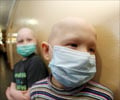A recent study shows that children's hospitals are not equipped to handle a major rush of patients in the event of a pandemic.

The study, published in the Centers for Disease Control and Prevention's Emerging Infectious Diseases journal, examined data from 34 children's hospitals as they dealt with the 2009 H1N1 pandemic, which disproportionately affected children.
Researchers found the median occupancy rate in the hospitals was 95 percent during the H1N1 pandemic but this situation did not differ from typical levels of high occupancy commonly experienced. In the 2008-09 flu season, the median occupancy was 101 percent. Fortunately, the pandemic turned out to be milder than expected. Still, the study said, it would have only taken about 0.2 admissions per 10 beds per day to reach 100 percent occupancy across all hospitals in the study.
"Models representing an outbreak of a more virulent influenza virus based on historical comparisons demonstrate that modest increases in emergency department visits or emergency department admissions rates would have resulted in substantial overcrowding among the large cohort of children's hospitals in our study," Sills wrote.
According to Sills, pandemics last for weeks or months and affect large geographical areas, often multiple nations or continents. And even if children's hospitals could handle such occupancy rates on a short-term basis, there are real questions of whether they could do so for a prolonged period.
The findings are especially significant in the context of national disaster planning related to children. The National Commission on Children and Disasters 2010 Report to the President and Congress found serious deficiencies in the state of disaster/pandemic preparedness for children and recommended the creation of a regionalized pediatric care system to help rectify these deficiencies.
Advertisement
She noted that while it might make financial sense to keep the hospitals 95 or 100 percent full, it might not make sense from a health care quality perspective.
Advertisement
Source-Eurekalert









